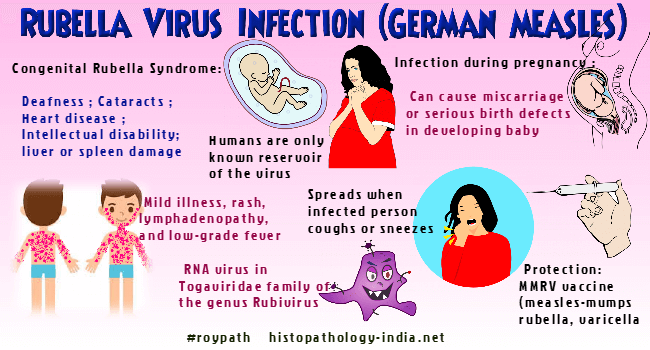|

Custom Search
|
|
Infectious Disease Online Pathology of German Measles (Rubella)
|

|
German measles, or rubella, is a mild, systemic infection of childhood. This contagious viral infection best known by its distinctive red rash is caused by a RNA virus in the Togaviridae family of the genus Rubivirus. In older children and adults, especially women, it may be more severe, with joint involvement and purpuric rash. Except for superficial similarity in the name, the rubella virus is not related to the measles (rubeola) virus. A worldwide disease, rubella is characterized by measles-like rash, low-grade fever, and swollen posterior auricular and occipital lymph nodes. The congenital rubella syndrome (CRS) involves multiple organ systems and has a long period of active infection and virus shedding in the postnatal period. Subclinical infections are common. The incubation period is 12 to 21 days, and the mild rash and other symptoms resolve within 3 days. Initially, swollen, nontender posterior auricular and occipital lymph nodes appear. A day or two later the nonpruritic rash begins on the face and rapidly spreads over the rest of the body, sparing the palms and soles. The virus is very contagious and is shed from the nasopharynx. The virus is also transmitted through the placenta, and rubella infections in pregnant women are a serious public health concern, because intrauterine infection causes spontaneous abortion, fetal death and a variety of congenital abnormalities. Infection during the first trimester is most serious. The classic triad of congenital rubella includes ocular abnormalities, heart disease, and deafness. The principal congenital abnormalities are patent ductus arteriosus, pulmonary and aortic stenosis, coarctation of the aorta, defects of the atrial or ventricular septum, ocular lesions (cataracts, glaucoma, and chorioretinitis), deafness, microcephaly, mental retardation, and retarded growth. Congenital rubella produces a classic salt-and-pepper pigmentation of the fundus. In suspected cases of rubella virus infection during pregnancy, or after contact of a pregnant woman with an infected person, a serological diagnosis must be performed. The diagnosis of an acute rubella virus infection usually consists of the detection of rubella-specific IgM.
|
|
|
Copyright © 2022 histopathology-india.net

